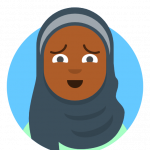3 Recognizing Stakeholders
How do we really enact a diverse and inclusive environment? How do we recognize differences? That is, how do we not only see differences but also honor them?
Learning Objectives
- Think critically about how “diversity” is enacted in workplaces.
- Conduct analyses of potential audiences while regarding each community member as a valuable part of this project’s mission, not just another person who you need to persuade to do something.
- Consider the stakes for each of the community members involved in this project.
Market logics claim to value a diverse and inclusive workforce. The consequence of valuing diversity only because it improves the bottom line is the tokenization or exploitation of already marginalized workers. Our rhetorical response to the tokenization and exploitation of diverse workers under the guise of diversity and inclusion is to recognize the barriers that marginalized populations face in a particular situation and try to collectively redress said barriers.
Recognition requires that we honor differences, not because of what they offer an organization economically, but because of the ways differences help us to understand how to build more livable communities. Recognition also requires us to attend to the larger, structural issues at play—not just individual, implicit biases.
Genres You Might Practice
- Audience analysis (informal report)
- Feasibility report
- Message testing
- Marketing proposal
Contemporary Conversations
In the following examples, consider and critique how recognition is practiced and/or how diversity is defined.
- Native Land Digital map of the world
- “Nike’s Colin Kaepernick ad campaign gets more yeas than nays from young people” [source: Washington Post]
- “Viola Davis Knows What’s Wrong With Hollywood… and How to Fix It” [source: Variety]
Professional Writer Spotlight
Below are quotes from our interviews with Evan, Rania, Frank, and Anthony, each of whom write professionally in for-profit or nonprofit organizations. We don’t necessarily endorse each of their opinions, but we think it’s worthwhile for you to know how actual professional writers think about how to perform recognition and diversity. Their perspectives come from having worked as professional writers in the world for at least the last 12 months or more.

Evan, on client interaction
“So, not just from a religious or kind of cultural background, we also look for socioeconomic background. So, we certainly, when appropriate, have hired a lot of our former clients. We have a lot of our employees who have faced either situational or generational poverty.
And so, they can not only sympathize with our clients, but they can empathize with them. And it’s important for us to make sure that we’re always have that in mind. In addition to that, we have frequent focus groups with our clients, and with our stakeholders, our funders. To understand, what is it that they are looking for? What is it that they need? What is it that they see our issues out in the community?
So, that we have a diverse thought, you know, in how we develop our programs and how we implement those programs.”

Rania, on recognition
“That’s the major goal, so right now, what we’re doing is, we put out another survey and saw what people define as recognition and why they feel like they are not being recognized. And have them tell us what they would like as recognition, because we do have second place recognition. We have peer-to-peer rewards, which is a points-based system when we help each other out.”

Frank, on resilience and recognition
“So part of resilience is helping people to really understand how they fit in, why it is what they do is important, how it fits into the ultimate product, and help them to get that people don’t always recognize or acknowledge what they’re doing, even though we should. That doesn’t mean that they aren’t incredibly valuable. It doesn’t mean they aren’t doing a great job.
Particularly dealing with lawyers, you’re dealing with people who are on some kind of a spectrum of anti-social behavior, so they’re not gonna be the kind of people who necessarily tell you “you’re doing great!” Because that’s just not who they are. There’s a lot of socialization that would really help people transition from their, whether it was law school or whatever else they were doing, into that kind of a setting.”

Anthony, on diversity and recognition
“So, with a city like New York that is incredibly ethnically diverse and has people from all over the place, all different kinds of sexual orientation and, not just a matter of white, black or brown. It’s a matter of every little, every single subset of everyone. It’s in, in the drilling down into these, these different groups, whether their ethnicity, whether it’s sexual orientation, whatever it may be, and then trying to determine where disparities lie to then correct them. But in sort of correcting you can over correct…And then alienate other groups of people.
So it’s, it’s this action-reaction and then reacting to the reaction and it’s this things, things tend to spiral out with very little control, but, it’s one of the challenges the city faces here and, including everybody in doing the best to represent populations of people. But sometimes it’s at the loss of other groups of people, so…But it’s a slippery slope sometimes.”
Tactical Questions
- How can your team conduct official, genred analyses of potential audiences while regarding each community member as a valuable part of this project’s mission, not just another person who you need to persuade to do something?
- What are the stakes or consequences for each of the community members involved in this project?
- What barriers, institutions, and/or structures shape how your team understands the differences in and between the audiences you’ve targeted for analyses? Who is absent from your audience analysis; why?
The presence of various identity groups in an organization or audience.
The representation and compensation of those from vulnerable identity groups. Not only acknowledging their presence, inclusion means valuing diversity both monetarily/materially and culturally within a workplace.
The rules of efficiency, productivity, austerity, and competition that inform corporate behaviors in a free market economy. These logics permeate other institutions when we take up their values in our practices and behavior.
An individualizing approach to inclusion, tokenization means an organization includes a representative of diversity without changing workplace values, rather than center the experiences and perspectives of those from a variety of cultures or backgrounds.
That which is required to be recognized in some kind of official capacity—e.g. as a citizen, a colleague, etc.
A document used to pitch to an organization (externally) or to those with decision making power (internally). Often composed multimodally – text, images, and even audio are used to illustrate prototype materials or project goals. Can be written in response to RFPs, but can also be directly elicited within an organization.